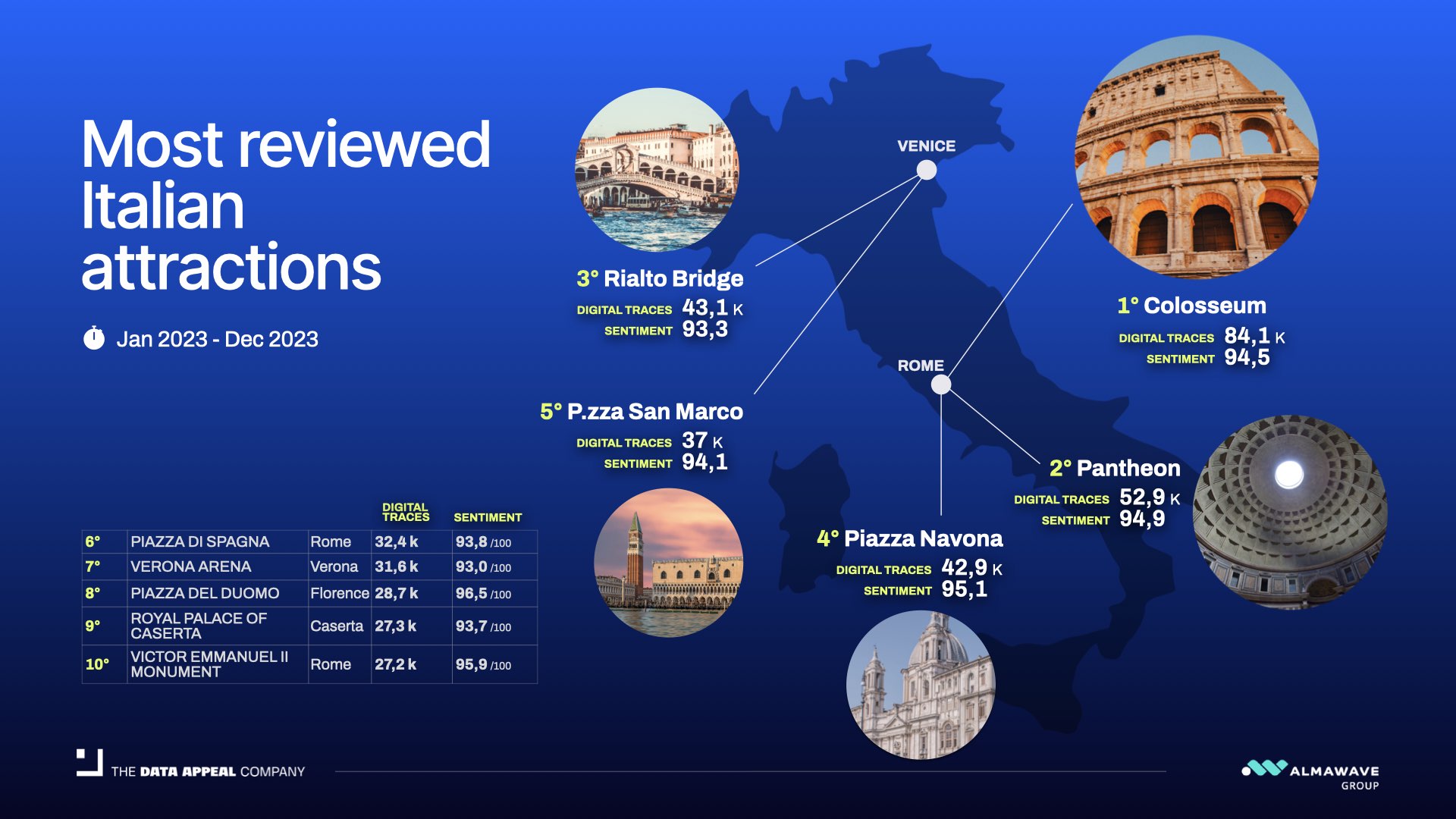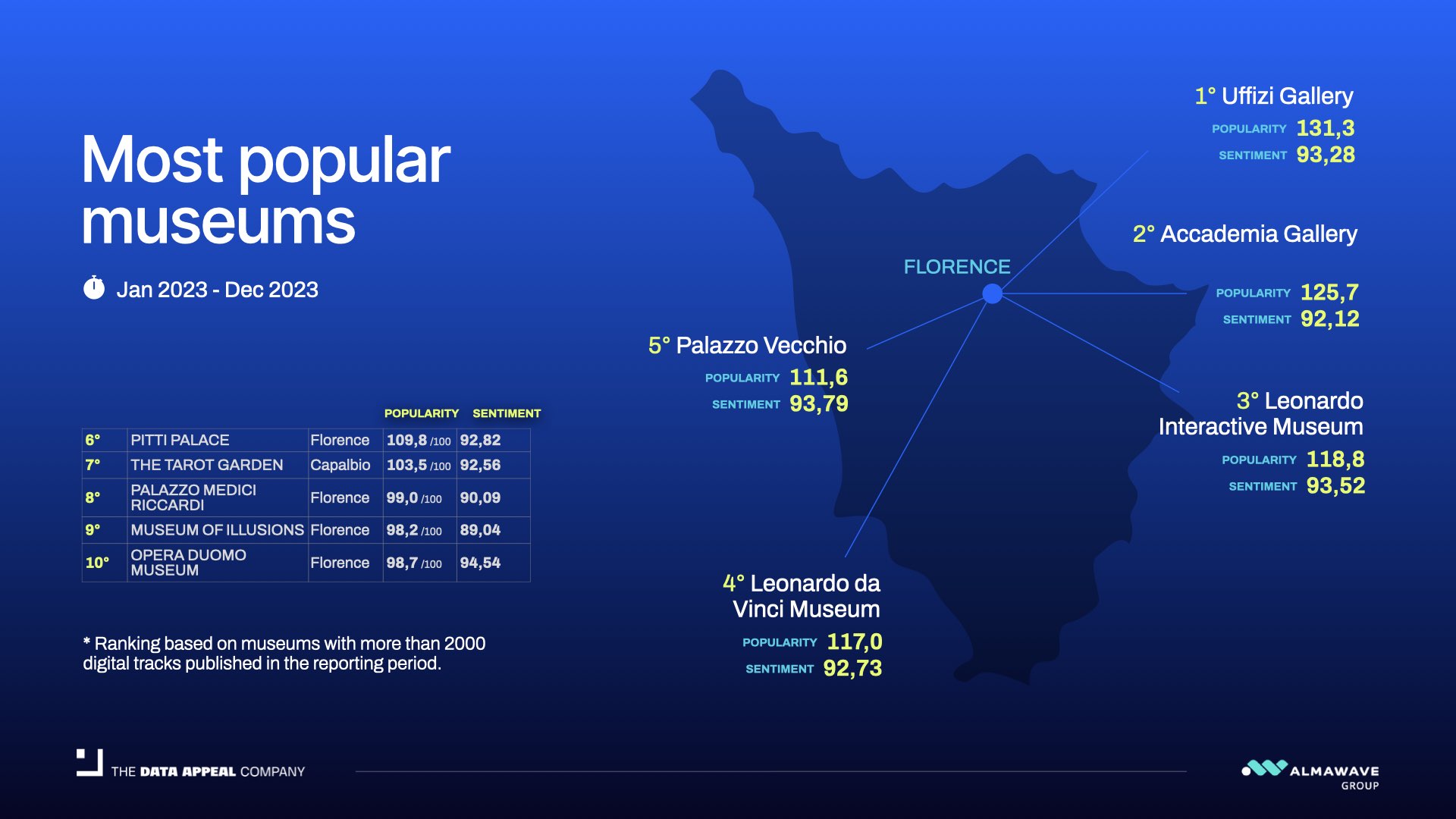According to the Italian National Institute of Statistics (Istat), out of all of Italy’s visitors, nearly 45% choose to explore cities, villages, towns, and cultural heritage sites. Throughout 2023, the Colosseum garnered the most reviews as a cultural attraction. However, the most beloved attraction was in Florence — more precisely, the Piazza Duomo.
This form of analysis concerning Points of Interest (POIs) in cultural tourism can play a pivotal role in shaping the content strategy for a tourist destination.
Let’s begin with the recent 2024 Cultural Tourism report for Italy, curated by The Data Appeal Company, to explore:
- The definition of cultural tourism POIs
- Understanding people’s preferences through POI Sentiment and Popularity
- Crafting valuable content using the most popular POIs
- Attracting the appropriate type of travellers
Content marketing: A treasure trove for tourist destinations
Both online and offline content marketing are pivotal in destination marketing strategies.
However, capturing attention in such a saturated market is becoming increasingly challenging — considering users are constantly bombarded with stimuli from social media, newsletters, and websites.
Let’s take planning a trip as an example. Travellers have an extensive selection of tools at their fingers, ranging from TikTok and Instagram to OTA platforms and forums.
And while the official website of a tourist destination remains an essential reference for users because it’s perceived as reliable and thorough, this platform alone isn’t enough.
To capture the interest of potential visitors, you need top-quality content that resonates with their preferences and aligns with market trends.
It’s only through the creation of compelling content that destinations can forge an emotional bond with their audience, and increase their likelihood to make a purchase.
Through videos, articles, blog posts, and social media updates, destinations not only provide information about their offerings but also generate anticipation and excitement — enhancing the desire to personally experience the attractions and locations.
But which content resonates the most with individuals? And which are the most appropriate topics, images, and videos?
And this is where Points of Interest (POI) analysis comes in. Proving to be an invaluable tool in crafting digital narratives.
What are cultural tourism POIs?
Points of interest (POIs) are physical locations or landmarks that hold significance within a specific area.
Among the POIs that are of particular interest to a tourist destination are those related to cultural tourism, such as:
- Museums
- Cultural attractions
- Archaeological parks
- Art galleries
Let’s leverage the insights from the 2024 Cultural Tourism report in Italy to show how crucial it is to analyse these POIs for content marketing.
The report, curated by The Data Appeal Company using our destination marketing and management platform D / AI Destinations provides information about the attractions with the highest number of reviews and, consequently, have been most visited, as well as those that are most appreciated by tourists.
Which cultural attractions and museums are the most appreciated and reviewed in Italy ?
Through a POI analysis, we easily ranked the top 10 most reviewed attractions in Italy in 2023: representing the most popular tourist routes in the country.
- Rome dominates the top 10 with 5 attractions (Colosseum, Pantheon, Piazza Navona, Spanish Steps, and Monument to Vittorio Emanuele II): Italy’s Capital alone accounts for almost 60% of all reviews among the top ten most reviewed cultural attractions.
- Following Rome is Venice with 2 attractions (Rialto Bridge and St. Mark’s Square), and finally, Verona with its Arena, Florence with Piazza Duomo, and Caserta with the Royal Palace.
- The Colosseum stands out significantly with over 84,000 reviews.
- The number of reviews for Piazza Duomo in Florence is markedly lower, but it claims the title of the cultural attraction with the highest Sentiment Score (96.5/100).

The Sentiment Score, representing the level of appreciation expressed online by the visitors, define a quite different ranking:
1. Cathedral Square of Florence – 96.5
2. Monument to Vittorio Emanuele II- 95.9
3. Piazza Navona – 95.1
4. Pantheon – 94.9
5. Colosseum – 94.5
6. St. Mark’s Square – 94.1
7. Spanish Steps – 93.8
8. Royal Palace of Caserta – 93.7
9. Rialto Bridge – 93.3
10. Arena of Verona – 93
According to the ranking of the most appreciated archaeological areas and museums at the national level, the top two archaeological sites include two of the most legendary in history: the Roman Forum and the Archaeological Park of Herculaneum.

Two lesser-known names also stand out: the Turin Automobile Museum in fourth place and the Trento Science Museum in fifth place, surpassing, albeit slightly, more classic destinations such as the Uffizi Gallery or the Royal Palace of Caserta.
A more in-depth focus on Tuscany reveals a similar trend. While the top ten list of museums with the highest Popularity (an index developed by Data Appeal that combines various aspects of the visitor experience, such as perceived quality and volume of content) is dominated by museums in Florence, we also find the splendid Tarot Garden in Capalbio in seventh place.
This indicates that travellers are becoming increasingly inclined to explore destinations and museums beyond the traditional travel routes.

Harnessing the popularity of key POIs to generate valuable content
So how do you use POI information to craft valuable content for travellers?
A destination can leverage its top POIs, along with insights into the typical visitor profile, to create videos and digital content that resonate with the interests, aspirations, and concerns of prospective tourists.
Integrating narrative aspects related to the most beloved attractions into these contents means capturing viewer attention and while motivating them explore those locations.
1 – Creating visually appealing content to build brand awareness
Visual content, including photos and videos, holds significant influence in the tourism industry.
Much like a child in a candy store, a traveller upon discovering the perfect vacation destination, immerses themselves in a mental journey, envisioning their upcoming adventure. They then take the steps to turn their dreams into reality by booking their holiday.
But among the numerous attractions of the destination, what is worth focusing on?
Understanding which points of interest (POIs) are the most reviewed, popular, and have the highest sentiment score will guide your choice.
The cultural points of interest (POIs) analysis we conducted for Italy reveals how the country is perceived in the collective imagination and what most travellers prioritise seeing during their trip. Neglecting these POIs in the visual strategy would be an oversight, as they serve as the most straightforward and effective way to capture the traveller’s attention.
You can use these POIs to create Instagram and Facebook posts, website backgrounds, reels, and videos to share.
Need an example? In 2023, Tourism Australia created one of its most discussed commercial videos. Many experts objected that the video only highlighted cliché locations. Yet, it was hugely successful internationally because evidently, the destination carefully studied the places and attractions most loved by tourists and built its narrative around them.
2 – Uncovering off-the-beaten-path attractions that captivate people’s attention
As we’ve seen, there are many lesser-known attractions that are highly appreciated by the public. In the case of Italy, examples of these POIs include the Tarot Garden in Tuscany, the Automobile Museum in Turin, and the Science Museum in Trento.
If the sentiment towards these attractions is high, it means they have the potential to attract and interest a wide audience, making it worthwhile to create content that highlights them: social media posts, videos, reels, informative cards, articles, and in-depth analysis.
This approach will allow the destination to stand out from other content creators, propose fresh ideas, and intrigue the audience with destinations that align with their interests.
3 – Develop a blog that matches your audience’s preferences
Most destination portals have a blog where they publish itineraries, travel ideas, tips, and news. However, it’s not always easy to come up with engaging topics.
Knowing which POIs are most loved by visitors provides an exceptional advantage because it allows writing articles around the most appreciated icons of the destination.
Plus, if those attractions are also the most searched online, the destination portal will have the additional advantage of achieving better SEO positioning among search results.

4 – Generating interest for ideal visitors
By combining information about Points of Interest with data on the origin and composition of travellers, we can craft content and marketing campaigns tailored to attract the visitors we aim to increase.
For example, the itinerary of an Italian visiting Rome for two days may be very different from that of an American staying for a week. If the destination wants to target American users, it can create customised content based on the attractions they prefer and use them for geolocated campaigns in America.
San Gimignano case study: Leveraging data analysis to boost revenues
Using data to craft effective marketing campaigns increases the likelihood of achieving goals more swiftly, without the risk of budget dispersion.
The renowned mediaeval village of San Gimignano understands this well.
Despite enjoying international fame, in recent years, San Gimignano has experienced a surge in day-trippers, with over 90% of visitors exploring the city within a single day and not opting to stay in hotels.
This trend was detrimental to the destination’s image and its local operators – hotels, restaurants, shops, etc.
By leveraging analysis of the most popular Points of Interest (POIs) and visitor origins conducted through the D/AI Destinations platform, San Gimignano created optimal online content and promotional campaigns to encourage longer stays.
In spring 2023, thanks to the effective use of collected data, San Gimignano experienced a significant increase in hotel stays and short-term rentals (+25%) compared to the previous year. The tourist season also expanded beyond the traditional months of May to September, stretching from April to November, demonstrating prolonged visitor interest.
Destination content marketing, too, should be data-driven
As we’ve seen, integrating Points of Interest into a destination’s digital narrative is not just a strategy to enhance visitor experience but also a fundamental pillar for standing out in an increasingly competitive tourism market.
Whether it’s uncovering the hidden history behind a lesser-known museum or showcasing the grandeur of a well-known attraction, each piece of content contributes to weaving the overall narrative of a destination.
To hit the mark, it’s essential to rely on data. On the digital traces that users leave behind. Only in this way can you ensure to choose themes and subjects that best reflect the dreams and desires of the audience.





